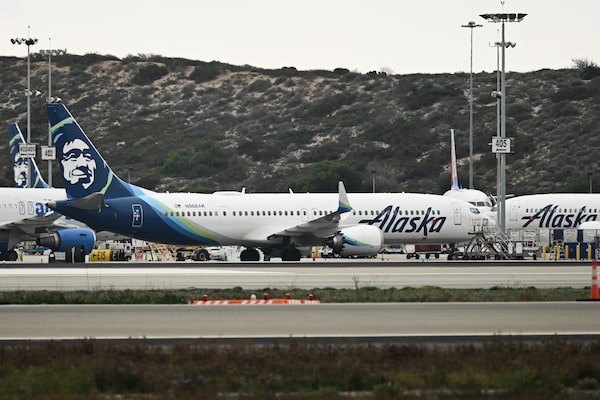
An Alaska Airlines Boeing 737 MAX 9 aircraft sits grounded near a maintenance hangar at Los Angeles International Airport in California, on Jan. 17.PATRICK T. FALLON/Getty Images
Gus Carlson is a U.S.-based columnist for The Globe and Mail.
As investigators probe the reason a door blew out of the fuselage of an Alaska Airlines Boeing 737 Max 9 jetliner in mid-flight earlier this month, critics of diversity, equity, inclusion and accessibility (DEIA) initiatives have pounced, intimating the near-catastrophic equipment failure is a symptom of a broader workplace effort to put hiring quotas ahead of quality and safety concerns. But those interested in making flying safer – rather than simply scoring political points – might want to look at a different contributing factor.
Critics, including Tesla founder Elon Musk, have used the Alaska Airlines incident to call out a U.S. Federal Aviation Administration policy that mandates recruiting people with severe mental disabilities, psychiatric problems and physical disabilities to meet the agency’s DEIA targets. While the FAA doesn’t manufacture aircraft or equipment, the insinuation is that as the governing body for civil aviation in the U.S., it is ultimately responsible for everything that happens aloft, including incidents like the Alaska Airlines failure that grounded all 737 Max 9 aircraft in the U.S.
On his X platform this week, Mr. Musk asked: “Do you want to fly in an airplane where they prioritized DEI hiring over your safety? That is actually happening. People will die due to DEI.”
Stanley Goldfarb, chairman of the health care advocacy group Do No Harm, agreed, less bombastically, telling Fox News that while people with disabilities who are capable of doing jobs should not face discrimination, the aviation and health care industries share responsibilities for safety that “outweigh other factors when considering applicants to work in those fields.”
While the connection may seem tenuous – and is unsubstantiated – fear-mongering is a powerful weapon on both sides of the politically charged debate over what’s fair versus what’s right, especially when it comes to high-profile, high-risk public-safety sectors such as commercial aviation and health care.
With the flying public chronically nervous about its safety, DEIA detractors aren’t about to waste a good crisis to make their point, even if the facts may not add up. Their message is clear: You can have safety or you can have diversity, but you can’t have both.
Ashley Nunes: Boeing isn’t the only one to blame for the Max 9′s problems
Analysis: Boeing’s Max 9 cabin blowout is cherry on top of industry frustration with the plane maker
In response to the criticism, the FAA said that across its 47,000 roles, there are all sorts of jobs for all sorts of people, including administrative positions, and it vets candidates carefully to ensure a proper fit between credentials and job requirements.
“Individuals with targeted disabilities have the greatest difficulty obtaining employment,” the FAA says on its recruiting website.
While proponents of DEIA dismiss the latest rhetoric as more partisan posturing, a continuing lawsuit makes a more direct connection between DEIA and the Alaska Airlines incident.
Spirit AeroSystems, which built the 737 Max 9 fuselage now under scrutiny and has bragged to shareholders about hitting its diversity hiring targets, is fighting a class-action lawsuit from a whistleblower who says the company de-emphasized safety in favour of hiring goals and profit.
The suit – filed in New York last month before the Alaska Airlines incident – says the company, a Boeing spin-off, eliminated teams of senior engineers and mechanics, leaving a disproportionate number of new and less experienced personnel that has had a negative effect on the quality of Spirit’s work and resulted in more rework and repairs.
To be clear, the claims in the whistle-blower suit have not been proven in court. And there is no evidence linking the FAA’s hiring policy to the Alaska Airlines incident. No reasonable person – or even a government bureaucrat – would presume the FAA would, for example, hire a person with severe mental disabilities for a high-risk role in air-traffic control.
But simply by raising the spectre of cause-and-effect, no matter how thin, the critics have created enough doubt to make their point. Rightly or wrongly, skittish fliers will connect the dots themselves.
There’s no question that in some cases DEIA initiatives have been pushed to the detriment of all concerned, including and especially candidates who find themselves in jobs for which they may not be qualified. But in this case, the detractors may be pointing their fingers in the wrong direction.
Lack of competition, not diversity, is more likely a contributing factor that led to the failure aboard the Alaska Airlines jetliner. As long as Boeing enjoys a duopoly – its only major competitor is Airbus – and juicy government contracts, it will have the luxury of putting costs ahead of quality no matter who does the work.